Features
‘Call of Duty WWII’ – Once More Unto the Beach, as Activision Takes the Series Back to Basics
Call of Duty has always had a special place in my heart. Unfortunately, it’s one that has been unoccupied for many years. Over the course of the last decade — two gaming generations — and ten main series entries, this venerable franchise, once adored by fans for its re-imagining of some of the most tragic and triumphant events of the Second World War, became little more than a frat boy gadget-fest where K/D ratio is king, and to the gulag with everything else. That’s not a value judgment; it’s just a fact that the target demographic shifted, and the series was altered accordingly. The beauty of the game industry is that there’s something for everyone, from casual mobile gamers like my very own mother, all the way up to the twitchiest of 360 no-scopers.
Each successive Call of Duty title has seemingly competed against the last for the most outrageous kill streak, the most bombastic missions, and most convoluted plot, so I can understand why Activision and the various development studios responsible for the series made the decision to change it so drastically. In an FPS market that was and largely still is dominated by only two intellectual properties (Battlefield and Call of Duty) something had to be done in order to differentiate the franchises. It was, for all intents and purposes, a prudent decision — one that proved far more profitable than the accountants at Activision probably ever imagined.
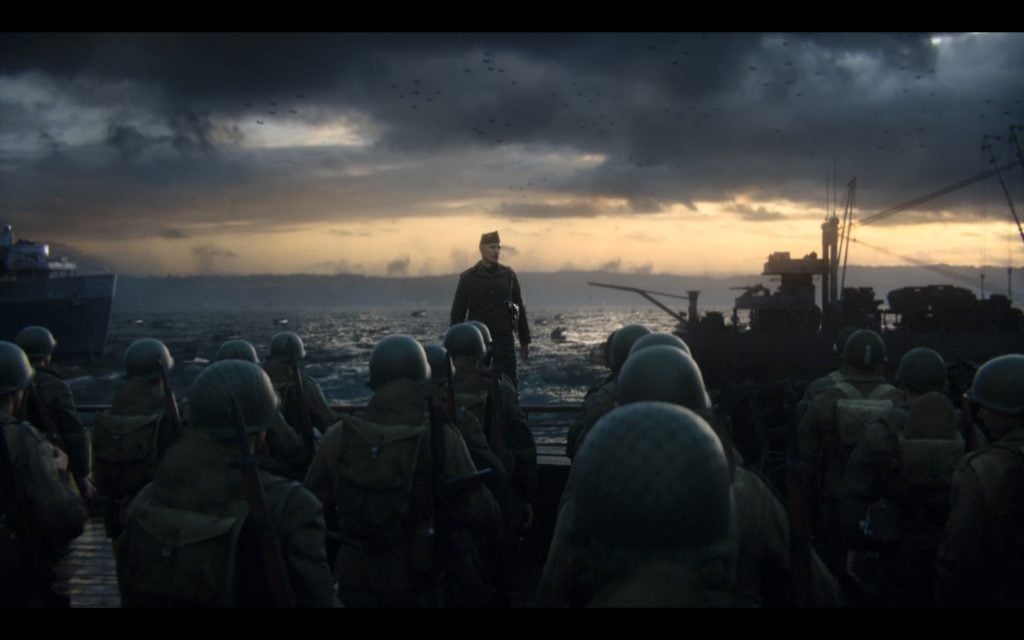
Since the release of Call of Duty: Modern Warfare in 2007, the series has grown to be one of the most commercially successful that has ever existed, and is largely responsible for Activision being in the prominent industry position that it presently enjoys. Old school fans such as myself may have fallen by the wayside over the years, left in the dust and mud to bleed out, but the new formula attracted and retained a larger audience (and more money) than ever before. Whatever the series may have gained from its transformation, it also lost something: its heart. For better and for worse, the Second World War, even seventy-two years after it concluded with the razing of Berlin and the nuclear obliteration of Hiroshima and Nagasaki, remains alongside World War One as one of the most momentous conflicts of the last century. The lessons etched in blood onto the pages of history that such conflicts serve to teach us as a species should never be forgotten, and yet relentless, hawkish lobbying from those who have forgotten the meaning of “lest we forget” constantly threaten to make history repeat itself.
Thankfully, with the campaign of Call of Duty: WWII, Sledgehammer Studios have taken the series back to its roots to serve as a reminder of not only what made the series so good in the first place, but also of exactly how much mankind suffered during what could arguably be considered the last “good” war. Or at least, the last war fought for entirely good reasons.
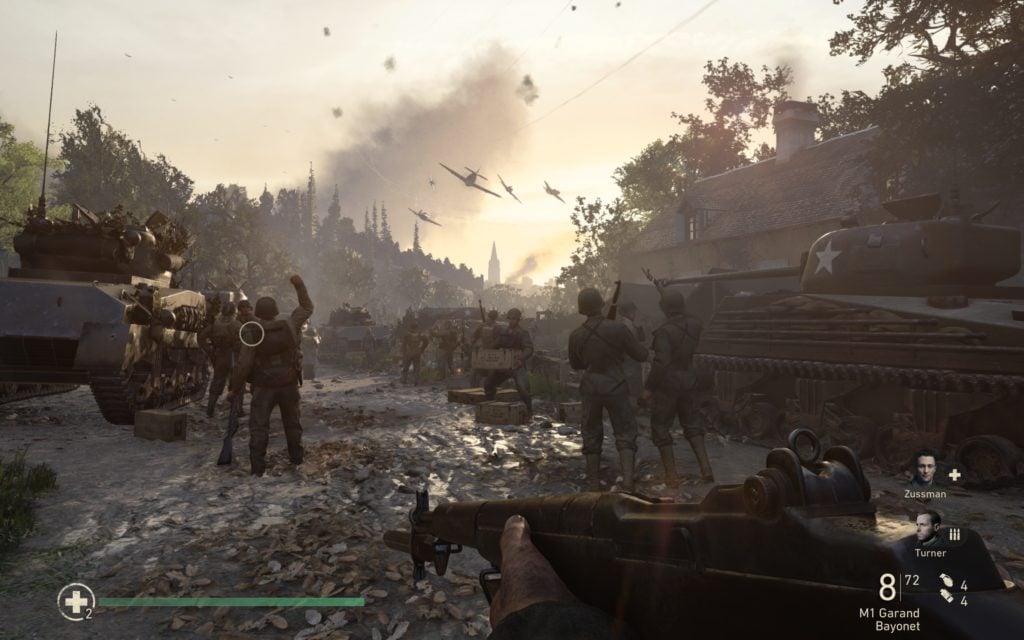
The inclusion of campaign modes in first-person shooters is largely viewed as an anachronism by most gamers and by the industry itself; at best they’re considered a holdover to cater to the tastes of older gamers, like me, and at worst they’re viewed as a waste of resources that could be better spent on more multiplayer content. However, as EA DICE realized too late when they released Star Wars Battlefront without a single player campaign in 2015, there is still significant consumer demand for them. The demand is so great in fact that I suspect that EA was all but forced to include just such a campaign mode in the upcoming sequel, or else face the near complete abandonment of the freshly rebooted series.
No matter how desperately the big publishers would like to scrap any commitment to single-player narratives in order to facilitate a “games as service” market where individual titles are designed to be perpetually monetized to ensure maximum profits for the least actual effort, it’s obvious that gamers aren’t willing to surrender on this matter. Not yet, at least. Realizing how important single player campaigns are to a significant proportion of players, Glen Schofield and his writing/design team were keen not to make the same mistake. An inordinate amount of careful planning and research went into the creation of the campaign in Call of Duty WW2, and the results are plain for all to see. Not only have Sledgehammer Studios managed to recapture some of the essence of what made the first three games so popular, but they have also reaffirmed why these single player elements are so fundamental to the genre.
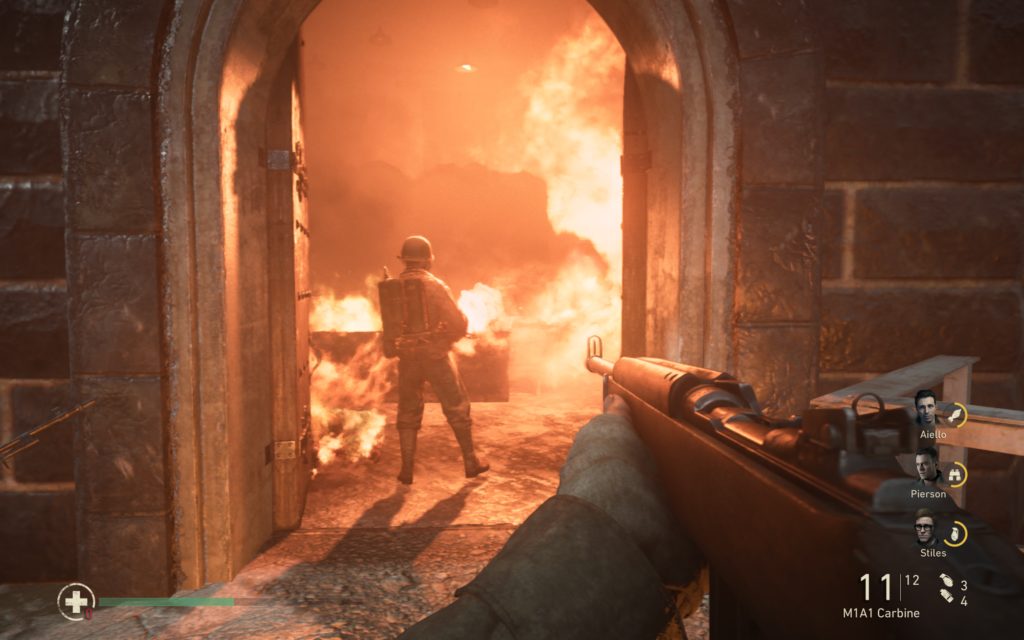
At roughly six hours long, the campaign of Call of Duty: WWII is no more substantial than those found in most of the previous games, but even in such a short space of time it manages to tell a heartfelt and heartbreaking story of sacrifice and survival, whilst simultaneously not skimping on Hollywood spectacle. Centered around the experiences of Ronald “Red” Daniels, a soldier in the 16th Regiment of the 1st Infantry Division of the United States Army, the campaign takes players from the blasted beaches of Normandy on D-Day, through the frost-bitten forests of the Belgian-German border, and all the way to the fortified banks of the river Rhine. As the front line advances, Daniels’ squad participates in several major battles of the war, including the Battle of Aachen, the liberation of Paris, and the Battle of the Bulge.
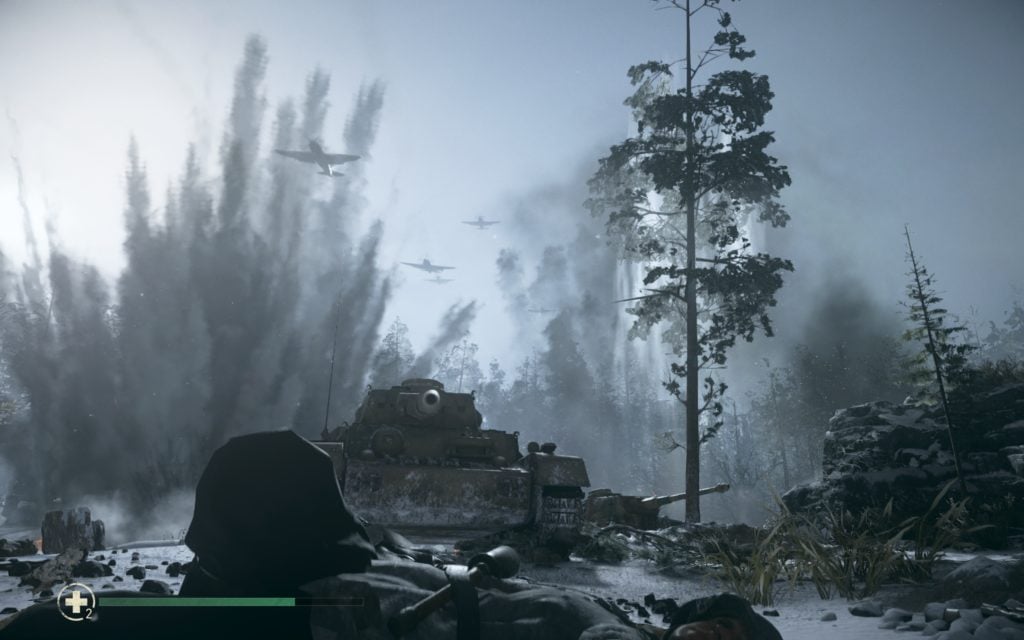
There are eleven campaign chapters that take place from June 1944 up to March 1945, each of which has its own individual structure that acts to complement and reinforce the dynamics of the overall narrative. For example, ‘The Battle of the Bulge’ mission begins with players delivering a crate of ammunition to a fellow soldier further up the defensive line, but rapidly deteriorates into a pitched battle beneath the boughs of the snow-smothered forest, culminating in a vicious standoff between infantry emplacements and an armored column as Nazi soldiers pour out of the smoke and mist like monsters from an ancient legend. The peaks and troughs of this mission, among others that have a similar internal escalation of action, all help to add much needed variation to the pace of the campaign. They make it so that each mission is as enjoyable whether played in isolation, or as considered a part of the greater whole.
The obligatory tank and aircraft sections are self-contained components of various missions, and allow players to see how their actions in the trenches and foxholes are but tiny parts of a conflict taking place across a much larger theater of war. These sections, underpinned by a superb Holst-inspired score provided by William Roget II, never fail to get the adrenaline pumping. There’s an infiltration mission with players bluffing their way into a foreboding Nazi barracks in the heart of occupied Paris that evokes the spirit of Agent Carter on more than one occasion, and is arguably the most interesting sequence of the entire game. If the focus had been placed entirely on stunning set piece moments (the explosive derailment of an armored train springs immediately to mind) then the underlying themes of the campaign may have been lost beneath the constant barrage of bullets and bombs.
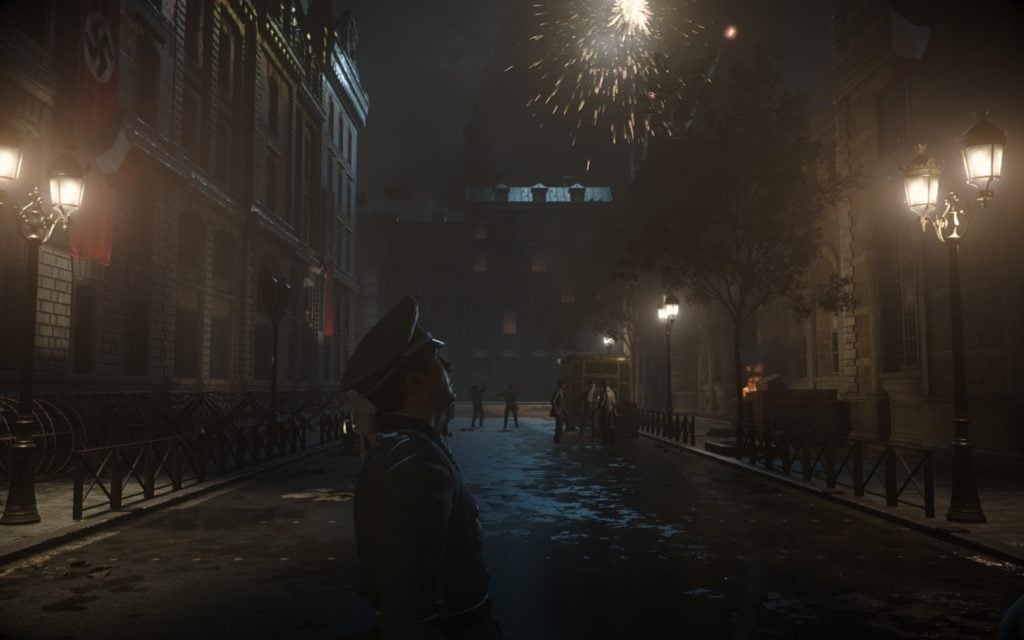
As the campaign advances, Daniels and his squad are forced to endure personal losses that make them question the likelihood of their survival, as well as facing up to the psychological and emotional impact that the constant threat of imminent death has on them as soldiers and as men. Although the members of the “greatest generation” are largely considered to be heroes by default, what the campaign here shows us is that they weren’t. The horrors they had to endure on a daily basis, and the fact that any of them even survived to return home at all, made them heroic. The ensemble cast does a sterling job of conveying the realities of warfare without ever becoming overly maudlin or jingoistic, and at no point did I ever feel like I was playing through a recruitment pitch for the US military — a factor of more recent entries in the series that I have always considered abhorrent by its very nature.
On the whole however, the campaign suffers from what I like to think of as a form of “Netflix Syndrome” with regards to its content. It tries to cover so much ground over such a short space of time in order to conform to the established format that, whilst in a general sense it hits all the right notes and goes out of its way to offer players a more grounded, recognizable, and ultimately more human glimpse at the nature of war, it’s never really given the chance to expand on its themes or characters.
The pacing is well-managed not just in individual missions, but also across the campaign as a whole. Excellent as it is, it still feels very by-the-numbers and could have done so much more to showcase the true effects of war. That said, the epilogue has to be one of the most outstanding sequences to be found in any game of this type produced in recent years. In the aftermath of the war, Daniels and his squad set out to search for one of their number who was captured in an earlier mission. As they begin to sweep work camps in the surrounding area, they — and by extension the player — are forced to confront the true horror of war, and indeed the inhumanity that men can demonstrate when given free rein. It’s a very short segment, but offers an invaluable and harrowing peek behind that particular curtain.
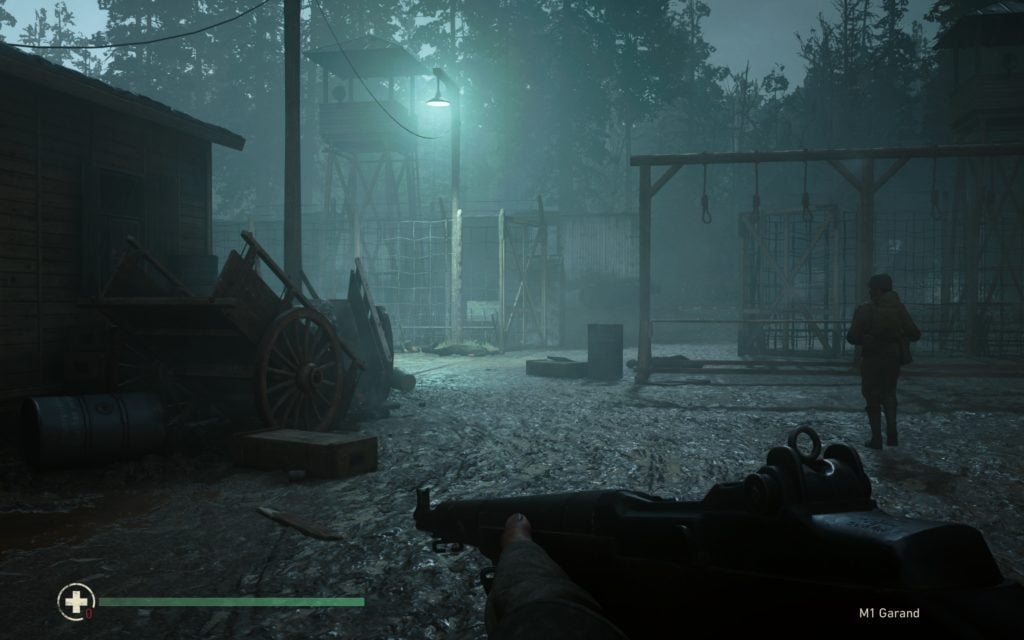
As for multiplayer, there’s obviously plenty of that, and it’s all the standard Call of Duty fare. I was hoping that a return to World War II would promote a more considered and measured approach to multiplayer combat, but unfortunately nothing could be further from the truth. It’s still aimed almost exclusively at those who have regular energy drink transfusions and have played nothing other than Call of Duty for the last ten years. There’s little to no explanation of anything in either the regular multiplayer or the fan favorite Nazi Zombie mode which deters newcomers like me right the from the start. The matchmaking seems slightly absurd, with low-ranking players thrown in alongside gamers who already have invested hours in the game. I can only imagine this was done to expose new players to the fancy equipment that higher-ranked players have unlocked to boost sales of loot boxes. That might make sense from a business point of view, but from the perspective of someone like me it just makes one not bother, as you essentially become a points pinata for those who don’t even need it.
Don’t get me wrong — I can see the quality. There is a broad range of weapons, attachments, and various cosmetic options to personalize your soldier. Progression does feel tangible and rewarding, the map design and overall level of presentation for the multiplayer elements is just as impressive as that present in the campaign. If this is your sort of thing, then you’ll doubtless get endless hours of entertainment out of it. With the exception of War mode, which pits Allies against Axis in a objective-based struggle for map control, it doesn’t do anything new, however, and just feels like more of the same. On top of that, the intrusive loot boxes seem specifically designed to exert passive psychological pressure on players in a way that stops being simply obnoxious and becomes aggressive panhandling. Multiplayer veterans will no doubt find more than enough here to keep them occupied, but I couldn’t help but feel that the experience rapidly grew stale, and found myself wishing that the developers had taken cues from more co-operative shooters such as Overwatch.
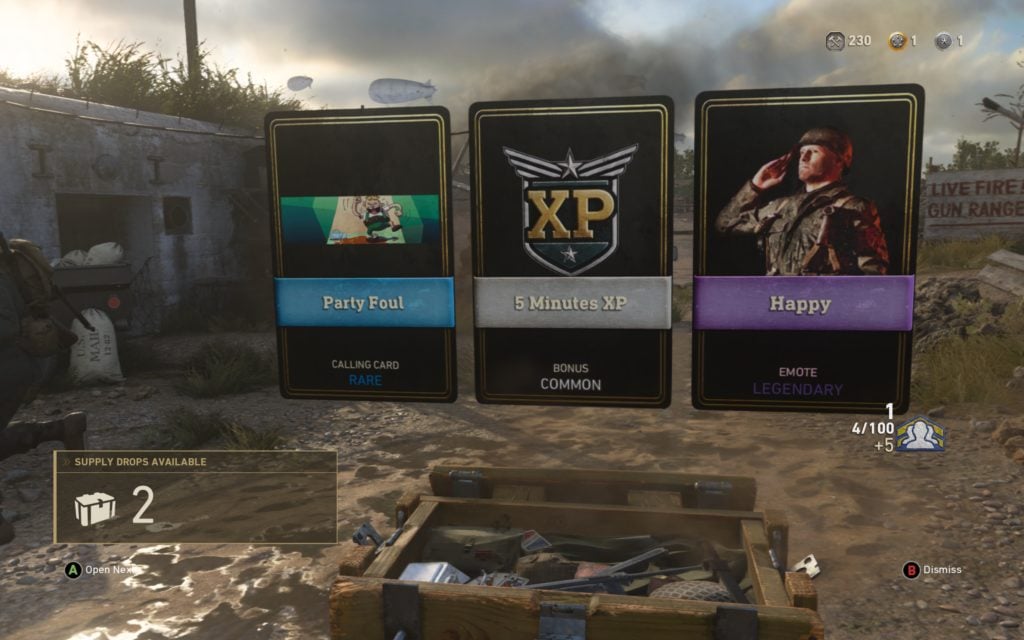
So, is Call of Duty WWII actually any good? Yes, undoubtedly. Could it have been better? Of course. However, it’s important to note that Sledgehammer Studios have taken the series, (for this entry at least) back to the very basics, and as such the developers can no longer depend on the gadgets, gizmos, and gimmicks that made even gamers who play nothing but these titles turn away from the franchise. It does suffer from a reliance on quick time events and A-to-B-to-C gameplay, but going back to what made the series so great to begin with, even on such an elementary level, gives Activision a chance to encourage fans who may have given up on the series to return, all while offering the long term fans a taste of something relatively fresh. Call of Duty: WWII may not be the absolute victory that some were hoping for, but at least its release will not be a day that lives in infamy.

-

 Features4 weeks ago
Features4 weeks agoThis Upcoming Romance Anime Might Just Break the Internet; Trailer Just Dropped!
-

 Features3 weeks ago
Features3 weeks agoDon’t Watch These 5 Fantasy Anime… Unless You Want to Be Obsessed
-

 Features2 weeks ago
Features2 weeks ago“Even if it’s used a little, it’s fine”: Demon Slayer Star Shrugs Off AI Threat
-

 Culture2 weeks ago
Culture2 weeks agoMultiplayer Online Gaming Communities Connect Players Across International Borders
-

 Game Reviews3 weeks ago
Game Reviews3 weeks agoHow Overcooked! 2 Made Ruining Friendships Fun
-

 Features4 days ago
Features4 days agoBest Cross-Platform Games for PC, PS5, Xbox, and Switch
-

 Guides3 weeks ago
Guides3 weeks agoMaking Gold in WoW: Smart, Steady, and Enjoyable
-

 Features2 weeks ago
Features2 weeks ago8 Video Games That Gradually Get Harder
-

 Game Reviews3 weeks ago
Game Reviews3 weeks agoHow Persona 5 Royal Critiques the Cult of Success
-

 Features1 week ago
Features1 week agoDon’t Miss This: Tokyo Revengers’ ‘Three Titans’ Arc Is What Fans Have Waited For!
-

 Game Reviews4 days ago
Game Reviews4 days agoFinal Fantasy VII Rebirth Review: A Worthy Successor?
-

 Guides1 week ago
Guides1 week agoHow to buy games on Steam without a credit card


